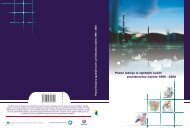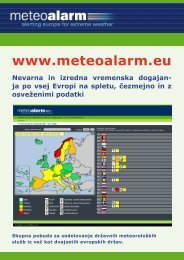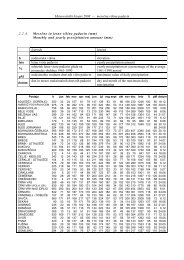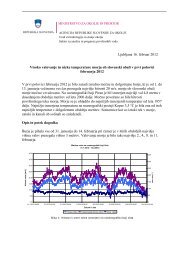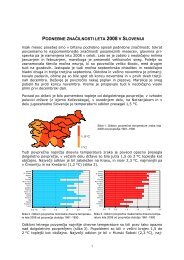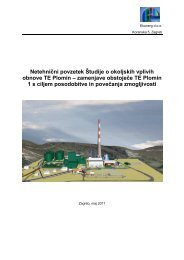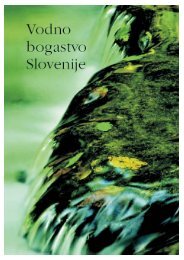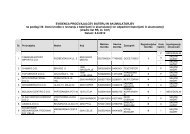Water Quality in Slovenia - Agencija RS za okolje
Water Quality in Slovenia - Agencija RS za okolje
Water Quality in Slovenia - Agencija RS za okolje
You also want an ePaper? Increase the reach of your titles
YUMPU automatically turns print PDFs into web optimized ePapers that Google loves.
Lake Bled<br />
S U R F A C E W A T E R S<br />
The establishment of monitor<strong>in</strong>g at Lake Bled and its <strong>in</strong>flows was related to remedial action for<br />
the improvement of the lake status that was <strong>in</strong> the ‘70s already eutrophic, occasionally even<br />
hypereutrophic. The status of Lake Bled has therefore been regularly monitored s<strong>in</strong>ce 1975. The<br />
results of monitor<strong>in</strong>g show that the artificial <strong>in</strong>flow the Radovna (1964), the siphon that functions<br />
as a depth outflow from the lake (1980/81) and the partial restoration of the sewage system <strong>in</strong><br />
Bled (1982–1985) contributed to the improvement of the status of Lake Bled. S<strong>in</strong>ce 1983, Lake Bled<br />
has been classified as a mesotrophic lake accord<strong>in</strong>g to OECD criteria. A reduction of the nutrients<br />
concentration and a general improvement of the Lake Bled status are apparent <strong>in</strong> the years 2003<br />
to 2006 <strong>in</strong> comparison with the years 1979 to 1981. But nevertheless, an occasionally <strong>in</strong>creased<br />
production of phytoplankton, expressed by a relatively high average concentration of chlorophyll-a,<br />
represents a warn<strong>in</strong>g about pressures from the lake bas<strong>in</strong>’s which cannot be entirely amended by<br />
the beneficial effects of restoration measures, the Radovna and by the siphon. In addition, the results<br />
of the monitor<strong>in</strong>g of <strong>in</strong>flows show that the concentration of phosphorus, which is the essential<br />
biogenic element, has been recently <strong>in</strong>creas<strong>in</strong>g <strong>in</strong> Mišca. On the basis of phosphorus, Table 7 shows<br />
the effectiveness of the siphon <strong>in</strong> remov<strong>in</strong>g the load from the lake and pollution load of Mišca <strong>in</strong> the<br />
years 2003 to 2006.<br />
Table 7: The annual <strong>in</strong>put and output of phosphorus by Mišca and the siphon <strong>in</strong> the years 2003 to 2006<br />
Year<br />
2003<br />
(kg P)<br />
2004<br />
(kg P)<br />
2005<br />
(kg P)<br />
2006<br />
(kg P)<br />
Siphon 308 266 217 260<br />
Mišca 231 372 335 402<br />
Lake Boh<strong>in</strong>j<br />
Accord<strong>in</strong>g to criteria set by the Group for Alp<strong>in</strong>e Lakes (34) <strong>in</strong> the process of <strong>in</strong>tercalibration of biological<br />
elements, Lake Boh<strong>in</strong>j belongs to the category of alp<strong>in</strong>e lakes where the impacts of human activity<br />
on the aquatic environment are either not present or are <strong>in</strong>significant. Additionally, accord<strong>in</strong>g to<br />
OECD criteria, Lake Boh<strong>in</strong>j was classified as a clear oligotrophic lake with low productivity <strong>in</strong> the years<br />
2003 to 2006, although the average concentration of nitrogen compounds exceeded the limit value<br />
for oligotrophic lakes. A high concentration of nitrogen compounds has been present <strong>in</strong> Lake Boh<strong>in</strong>j<br />
s<strong>in</strong>ce the beg<strong>in</strong>n<strong>in</strong>g of monitor<strong>in</strong>g of the lake’s status (1993) and is not <strong>in</strong>creas<strong>in</strong>g, which <strong>in</strong>dicates<br />
that it is the natural state. With regards to phytoplankton, some species occasionally appear that<br />
were not present <strong>in</strong> previous years and are characteristic of more productive lakes. An assessment of<br />
the ecological status of Lake Boh<strong>in</strong>j will be made when the assessment methods for other biological<br />
elements are ready and will also <strong>in</strong>clude other pressures and not just the eutrophication.<br />
Coccal green algae Nephrocytiun agardhianum, characteristic of more productive lakes, which also appeared <strong>in</strong> Lake<br />
Boh<strong>in</strong>j <strong>in</strong> the years 2003 to 2006.<br />
31




